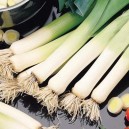
Welcome, Log in
Product Categories
-
Heirloom & OP Seed
- Cool Weather Crops
- Warm Weather Crops
- Beans
- Beetroot
- Brassicas
- Carrots
- Chard
- Corn/Maize
- Cucumbers
- Eggplant (Aubergine)
- Leeks
- Lettuce
- Melons
- Okra
- Onions
- Parsnips
- Peas
- Peppers & Chillies
- Radish
- Spinach
- Squash & Pumpkins
- Tomatoes
- Turnips
- Unusual / Exotic
- Herbs & Spices
- Fruits & Berries
- Value Packs
- View All Seed
- Gift Vouchers
LeeksThere is 1 product.
Please scroll down or click here to view the product list
GROWING INSTRUCTIONS FOR LEEKS
Binomial Name: Allium
Varieties: Bulgarian Giant, Carentan
Start: Seeds or seedlings
Germination: 5 - 7 days, 7°C to 35°C
Seed Life (viability): 3 years
Soil: Well drained, high fertlity
Sunlight: Full sun, part shade
Sow Seeds: 3 cm apart
Transplant Seedlings: 12 to 15 cm apart
Ave. Days to Harvest: 50 to 75
Good Companions: Cabbage, carrot, celery, endive, kohlrabi, lettuce, pepper, strawberry, tomato, yarrow
Bad Companions: Beans, beetroot, onion, peas
Sowing & Planting: Leeks are milder flavored than most other onion-family crops, you can mulch long-season varieties in fall for winter and spring harvest. Choose a weed-free, well-drained location with rich soil, high in organic matter. Optimum pH is 6.2 to 6.8. Requires plentiful, even moisture for good yields. Raised beds are ideal. Leeks are good for intercropping with other garden plants, especially early-maturing spring greens. Do not plant where other onion family crops have been grown in the past 3 years.
You can direct-seed leeks or start seedlings indoors. Long-season varieties are best started indoors. Start seedlings about 8 to 10 weeks before last frost date. Sow seeds in flats about 0.5 cm apart and 1 cm deep. Transplant to cell-type containers when they are about 5 cm tall. If you skip this step and continue growing in open flats, simply tease apart and trim roots when transplanting into the garden.
Around the average last day of frost, set hardened-off transplants 10 to 20 cm deep, 10 to 15 cm apart, in rows 50 cm apart. Deep planting reduces need for hilling to blanch the base of the plants. Transplants should be about 15 to 30 cm tall - the bigger, the better. Only a few centimeters of leaf need to show above the soil. Direct seed about 4 weeks before average last frost 1 cm deep, 1 cm apart, in rows 50 cm apart. Thin to 10 to 15 cm apart.
Growing: Hill or mound soil around stems several times to blanch as leeks grow. (A single large hilling while plants are young can cause them to rot.) Or, place a portion of cardboard paper towel center around the lower part of the stem.
Leeks have shallow root systems and need consistent moisture and good weed control. Water weekly if weather is dry, and mulch to retain moisture and suppress weeds.
Harvesting: Leeks are easy to harvest. They have a relatively long growing season, meaning you can harvest leeks all summer long in some areas. After the harvest begins, prolong it by only picking the leeks you plan to use, allowing the rest to continue growing.
When to Harvest - Leeks are typically harvested during late summer or early autumn. In practice, leek harvesting can begin about 60 days after planting and continue until the harvest is complete, or the weather makes further harvest unfeasible. Be aware of the weather and fully harvest all remaining leeks ahead of the first hard freeze.
How to Harvest - Vegetable garden leeks should be removed whole. If you grip the top of the plant and pull, it is likely to break, and much of the leeks will be lost. Instead, loosen the soil with your fingers and lift out the leeks by their root systems.
Prolong Harvest for Soil Protection - You can continue growing leeks until the first hard frost kills them back. By harvesting slowly, you allow the unharvested leeks to grow larger and more flavorful. Only pick what you need until the danger of a freeze prompts completing the full harvest.






